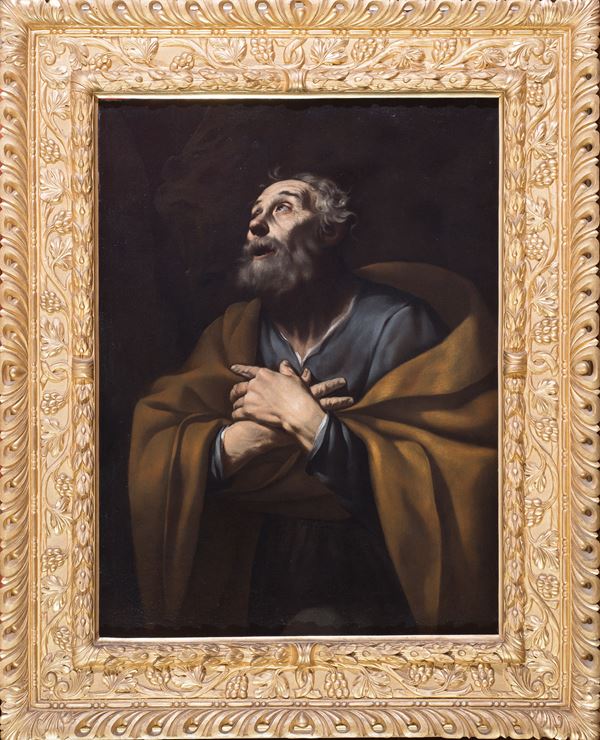137
Scuola napoletana, XVII secolo
Un pellegrino
Oil on canvas
cm 98x74
The painting is mentioned in the inventory of 26 June 1713, by Don Giovanni Battista Rospigliosi, Duke of Zagarolo, at n.252, with the diction "a painting in similar canvas (referring to the previous number, "half-head" corresponding to about 100x75 cm) represents a Pilgrim with hands joined to the chest, work of the Spaniard".
The back of the frame bears the sealing wax seal affixed by Clorinda Carafa della Stadera, XI Princess of Colubrano and Duchess of Maddaloni, which allows you to reconstruct the history of the painting.
The patron of the work can almost certainly be identified in Cardinal Lazzaro Pallavicino (1602-1680) who in 1679 through a will donated it, along with many other works, to his niece Maria Camilla Pallavicino, the only descendant of the Pallavicino branch, who marries Don Giovanni Battista Rospigliosi assuming, with her husband, the commitment that the first of her children will continue to be called Rospigliosi and the second, instead, will carry the surname Pallavicino and so in the future.
Giovanni Battista in turn had an inventory compiled of his large picture gallery (see manuscript in the Archivio Pallavicini, vol. A-S-1, published by Federico Zeri in 1959) to leave his assets to his eldest son, Clemente Domenico, (1674-1752), who married Giustina Borromeo, grandson of San Carlo Borromeo. The painting goes to Clemente Domenico’s third daughter, Caterina, and later to her daughter Alfonsina, who marries Don Michele Carafa della Stadera, 7th Prince of Colubrano. He then passed to their second son, Don Domenico, 9th Prince of Colubrano. Domenico has two sons, Marzio Gaetano, X Prince of Colubrano and Clorinda, XI Princess of Colubrano, Duchess of Maddaloni who marries in 1820 Don Donato Proto Pallavicino and affixes the seal on the back of the frame, with in the center the coat of arms Carafa surmounted by the Papal Umbrella, (to indicate the privilege of having a Pope in the family) where on the left is the coat of arms of Casa Proto and on the right the coat of arms Pallavicino. The affixing of the seal dates back, presumably, to the sixties of the nineteenth century, and it is precisely at that time that we can date the complete restoration of the ancient and original frame of the painting.
Giovanni Battista in turn had an inventory compiled of his large picture gallery (see manuscript in the Archivio Pallavicini, vol. A-S-1, published by Federico Zeri in 1959) to leave his assets to his eldest son, Clemente Domenico, (1674-1752), who married Giustina Borromeo, grandson of San Carlo Borromeo. The painting goes to Clemente Domenico’s third daughter, Caterina, and later to her daughter Alfonsina, who marries Don Michele Carafa della Stadera, 7th Prince of Colubrano. He then passed to their second son, Don Domenico, 9th Prince of Colubrano. Domenico has two sons, Marzio Gaetano, X Prince of Colubrano and Clorinda, XI Princess of Colubrano, Duchess of Maddaloni who marries in 1820 Don Donato Proto Pallavicino and affixes the seal on the back of the frame, with in the center the coat of arms Carafa surmounted by the Papal Umbrella, (to indicate the privilege of having a Pope in the family) where on the left is the coat of arms of Casa Proto and on the right the coat of arms Pallavicino. The affixing of the seal dates back, presumably, to the sixties of the nineteenth century, and it is precisely at that time that we can date the complete restoration of the ancient and original frame of the painting.
€ 18.000,00 / 20.000,00
Estimate








